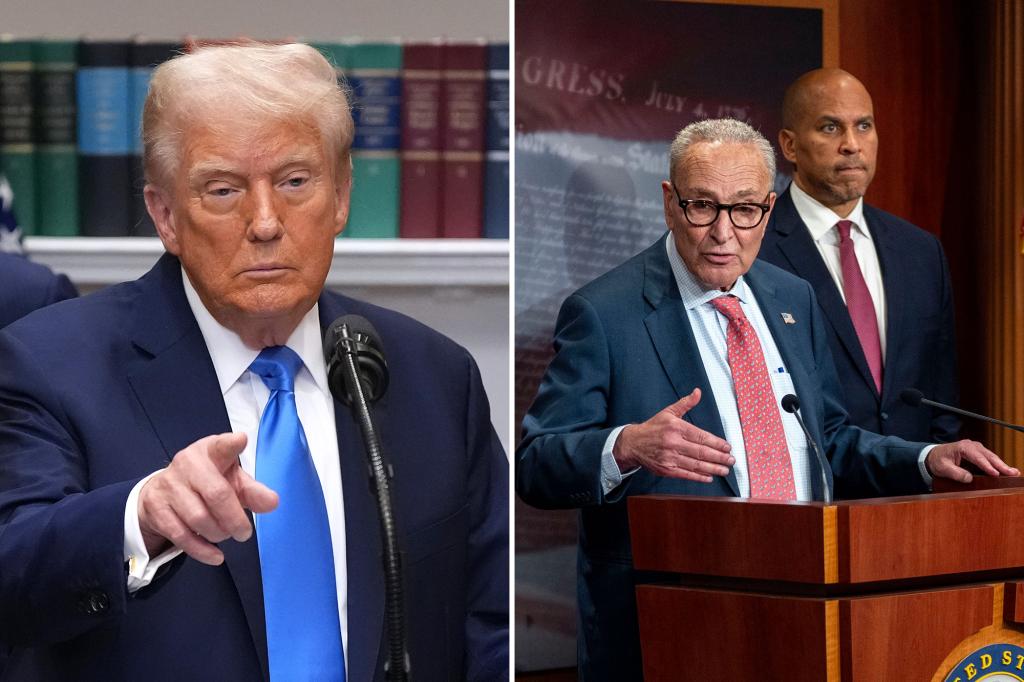Trump to Meet with Democratic Leaders as Government Shutdown Looms
In a critical turn of events, President Trump has agreed to meet with Democratic congressional leaders this week as the nation faces an imminent government shutdown deadline on September 30. The White House has confirmed that Trump will sit down with Senate Minority Leader Chuck Schumer and House Minority Leader Hakeem Jeffries, both Democrats from New York, in what appears to be a last-ditch effort to prevent a federal funding crisis. The meeting, reportedly scheduled for Thursday, comes at a time when partisan tensions are running particularly high over budget negotiations and healthcare policies.
The development emerged after Schumer and Jeffries took the unusual step of sending a formal letter to the president on Saturday, explicitly “demanding” a meeting. Their bold move came just one day after Senate Democrats showed their collective strength, with all but two members rejecting a Republican-proposed stopgap funding bill that would have maintained current government funding levels through November 21. This decisive vote signaled that Democrats are unwilling to accept temporary solutions without addressing their broader concerns, particularly regarding healthcare policies which they believe Republicans are attempting to undermine. The timing of the letter – immediately following the failed vote – suggests a calculated strategy to force direct engagement with the president rather than continuing negotiations through congressional intermediaries.
In their strongly worded letter, the Democratic leaders did not mince words, accusing the president of deliberately steering the country toward a government shutdown due to “the Republican desire to continue to gut the healthcare of the American people.” This framing attempts to place the responsibility for any potential shutdown squarely on the president’s shoulders while positioning Democrats as defenders of Americans’ healthcare rights. Schumer and Jeffries further claimed that Republican congressional leadership, acting under Trump’s direction, has “repeatedly” refused to engage in good-faith bipartisan negotiations to keep the government functioning. Their assertion that it is “now your obligation to meet with us directly” reflects an attempt to bypass what Democrats see as unproductive discussions with Republican legislators and instead engage directly with the ultimate decision-maker.
The White House’s initial response to the Democratic leaders’ demands revealed the deep divide between the parties’ perspectives on the ongoing negotiations. A White House official characterized the Democrats’ letter as showing “desperation” and countered their narrative by claiming that “Dems walked away from a bipartisan negotiation” on the continuing resolution that would have kept the government funded temporarily. This exchange of accusations highlights how both sides are engaged not only in negotiations over government funding but also in a public relations battle to control the narrative about who bears responsibility for the potential shutdown. With each side blaming the other for abandoning good-faith negotiations, finding common ground becomes increasingly challenging as the deadline approaches.
As the September 30 deadline looms ever closer, this high-stakes meeting represents perhaps the last significant opportunity to avert a government shutdown that would affect millions of Americans. Government shutdowns typically result in furloughs for federal workers, disruptions to government services, and potential economic impacts that ripple throughout the economy. The issues at the heart of this standoff extend beyond simple budgetary considerations to include fundamental disagreements about healthcare policy, reflecting the deeply polarized nature of contemporary American politics. Both sides appear to be calculating not only the practical implications of a shutdown but also the political consequences of being blamed for failing to reach a compromise.
The upcoming meeting between President Trump and the Democratic leaders will be closely watched as a potential turning point in this fiscal standoff. If productive, it could pave the way for a compromise that keeps the government operating while addressing at least some of each side’s priorities. If unsuccessful, the nation faces the prospect of its first government shutdown under the second Trump administration, testing the president’s deal-making abilities and potentially setting the tone for legislative relations throughout his term. With the clock ticking and positions seemingly hardened on both sides, the pressure to find common ground intensifies by the hour, even as both parties continue to position themselves to avoid political blame should negotiations ultimately fail. The American public, meanwhile, awaits the outcome of these high-level discussions that will determine whether essential government functions continue uninterrupted beyond the end of the month.











